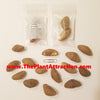Thevetia Peruviana 4 Seeds, Shrub Or Small Tree, Neriifolia, Cascabela, Fragrant Yellow Oleander
Thevetia Peruviana
Also known as: Thevetia neriifolia, Cascabela thevetia, Yellow Oleander , Lucky Nut, Be Still Tree
This tropical shrub or small tree is native to the West Indies, southern Mexico and Belize. It will grow to about 8-20 feet tall, but even taller in its wild native land. The large fragrant trumpet-shaped flowers are most prolific from spring to fall, but continue through winter if temperatures remain mild. Borne at the stem tips, they range in color from yellow to warm peach. Once the flowers bloom, expect pollinators, butterflies and hummingbirds to flock into your landscape area. Rounded green fruits follow the flowers and turn black when mature. The fruit contains a nut, that contains 2 seeds each, and that nut has traditionally been used as good luck charms or for necklaces.
The narrow glossy evergreen leaves and stems contain a milky latex that may cause dermatitis. All parts of the plant are poisonous if ingested. Smoke from burning plant material can also be toxic. So be aware of this when choosing a location around children & pets.
Grows in full sun and well-drained moderately fertile soil. Tolerant of heat, drought, and seaside conditions. In fact, it thrives in the heat and will bloom in the heat all year long if the winters are warm. Low to moderate water use once established. This fast growing tree is useful for shading sidewalks, roadsides, and beaches. In the garden, use it as a small shade tree or in hedges and screens. In regions that experience light winter freezes the plant vigorously regrows and blooms as a dense shrub, behaving as a herbaceous perennial. It also works as an indoor or outdoor colorful container plant. USDA zone 8-10.
This offer is for 2 large nuts / 4 seeds.
*Each nut contains 2 seeds each, see last photo for an example.
Also known as: Thevetia neriifolia, Cascabela thevetia, Yellow Oleander , Lucky Nut, Be Still Tree
This tropical shrub or small tree is native to the West Indies, southern Mexico and Belize. It will grow to about 8-20 feet tall, but even taller in its wild native land. The large fragrant trumpet-shaped flowers are most prolific from spring to fall, but continue through winter if temperatures remain mild. Borne at the stem tips, they range in color from yellow to warm peach. Once the flowers bloom, expect pollinators, butterflies and hummingbirds to flock into your landscape area. Rounded green fruits follow the flowers and turn black when mature. The fruit contains a nut, that contains 2 seeds each, and that nut has traditionally been used as good luck charms or for necklaces.
The narrow glossy evergreen leaves and stems contain a milky latex that may cause dermatitis. All parts of the plant are poisonous if ingested. Smoke from burning plant material can also be toxic. So be aware of this when choosing a location around children & pets.
Grows in full sun and well-drained moderately fertile soil. Tolerant of heat, drought, and seaside conditions. In fact, it thrives in the heat and will bloom in the heat all year long if the winters are warm. Low to moderate water use once established. This fast growing tree is useful for shading sidewalks, roadsides, and beaches. In the garden, use it as a small shade tree or in hedges and screens. In regions that experience light winter freezes the plant vigorously regrows and blooms as a dense shrub, behaving as a herbaceous perennial. It also works as an indoor or outdoor colorful container plant. USDA zone 8-10.
This offer is for 2 large nuts / 4 seeds.
*Each nut contains 2 seeds each, see last photo for an example.

























